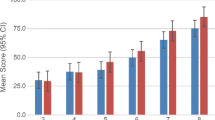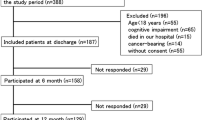Abstract
The aims of the study were to examine whether self-reported physical health changes over the first 5 years after traumatic brain injury (TBI), and whether the trajectories of physical health over that time period could be predicted by demographic and injury-related variables. A longitudinal cohort study was conducted with 97 individuals with moderate-to-severe TBI who had been admitted to a Trauma Referral Centre in 2005/2007. Patients were followed up at 1, 2 and 5 years post-injury. Physical health-related quality of life (HRQL) (i.e., physical health) was measured by four subscales of the Medical Outcomes 36-Item Short Form Health Survey (SF-36): Physical Functioning, Role–Physical, Bodily Pain and General Health. Only the Physical Functioning domain showed statistically significant improvements across time. Women had lower scores on Role–Physical, Bodily Pain (more pain) and General Health. Unemployment prior to injury and having been in a “blue collar” physical job was associated with lower Physical Functioning and General Health, while greater TBI severity was associated with lower Physical Functioning, but better Role–Physical. Bodily Pain, Role–Physical and General Health remained fairly stable over time, despite the improvement in Physical Functioning. There were a number of significant injury-related and demographic predictors across the four trajectories of physical health. A better understanding of factors influencing these domains over the first 5 years after TBI and effective pain reducing rehabilitation strategies are needed.







Similar content being viewed by others
Reference
Ruttan L, Martin K, Liu A, Colella B, Green RE (2008) Long-term cognitive outcome in moderate to severe traumatic brain injury: a meta-analysis examining timed and untimed tests at 1 and 4.5 or more years after injury. Arch Phys Med Rehabil 89(12 Suppl):S69–S76
Andelic N, Arango-Lasprilla JC, Roe C (2013) The complexity of traumatic brain injury. Forward. J Rehabil Med 45(8):708–709
Sigurdardottir S, Andelic N, Roe C, Schanke AK (2009) Cognitive recovery and predictors of functional outcome 1 year after traumatic brain injury. J Int Neuropsychol Soc 15(5):740–750
Sigurdardottir S, Andelic N, Roe C, Schanke AK (2013) Depressive symptoms and psychological distress during the first five years after traumatic brain injury: Relationship with psychosocial stressors, fatigue and pain. J Rehabil Med 45:808–814
Andelic N, Hammergren N, Bautz-Holter E, Sveen U, Brunborg C, Roe C (2009) Functional outcome and health-related quality of life 10 years after moderate-to-severe traumatic brain injury. Acta Neurol Scand 120(1):16–23
Resch JA, Villarreal V, Johnson CL, Elliott TR, Kwok OM, Berry JW, Underhill AT (2009) Trajectories of life satisfaction in the first 5 years following traumatic brain injury. Rehabil Psychol 54(1):51–59
Truelle JL, Koskinen S, Hawthorne G, Sarajuuri J, Formisano R, Von WK, Neugebauer E, Wilson L, Gibbons H, Powell J, Bullinger M, Hofer S, Maas A, Zitnay G, Von SN (2010) Quality of life after traumatic brain injury: the clinical use of the QOLIBRI, a novel disease-specific instrument. Brain Inj 24(11):1272–1291
Ponsford J, Draper K, Schonberger M (2008) Functional outcome 10 years after traumatic brain injury: its relationship with demographic, injury severity, and cognitive and emotional status. J Int Neuropsychol Soc 14(2):233–242
Brown M, Vandergoot D (1998) Quality of life for individuals with traumatic brain injury: comparison with others living in the community. J Head Trauma Rehabil 13(4):1–23
Colantonio A, Dawson DR, McLellan BA (1998) Head injury in young adults: long-term outcome. Arch Phys Med Rehabil 79(5):550–558
Forslund MV, Roe C, Sigurdardottir S, Andelic N (2013) Predicting health-related quality of life 2 years after moderate-to-severe traumatic brain injury. Acta Neurol Scand 128(4):220–227
Koskinen S (1998) Quality of life 10 years after a very severe traumatic brain injury (TBI): the perspective of the injured and the closest relative. Brain Inj 12(8):631–648
Dijkers MP (2004) Quality of life after traumatic brain injury: a review of research approaches and findings. Arch Phys Med Rehabil 85(4 Suppl 2):S21–S35
Hu XB, Feng Z, Fan YC, Xiong ZY, Huang QW (2012) Health-related quality-of-life after traumatic brain injury: a 2-year follow-up study in Wuhan, China. Brain Inj 26(2):183–187
Grauwmeijer E, Heijenbrok-Kal MH, Ribbers GM (2014) Health-related quality of life 3 years after moderate to severe traumatic brain injury: a prospective cohort study. Arch Phys Med Rehabil 95(7):1268–1276
Kwok OM, Underhill AT, Berry JW, Luo W, Elliott TR, Yoon M (2008) Analyzing Longitudinal Data with Multilevel Models: an Example with Individuals Living with Lower Extremity Intra-articular Fractures. Rehabil Psychol 53(3):370–386
Ponsford J (2013) Factors contributing to outcome following traumatic brain injury. NeuroRehabilitation 32(4):803–815
Teasdale G, Jennett B (1974) Assessment of coma and impaired consciousness. A practical scale. Lancet 2(7872):81–84
Forslund MV, Arango-Lasprilla JC, Roe C, Perrin PB, Sigurdardottir S, Andelic N (2014) Multi-level modelling of employment probability trajectories and employment stability at 1, 2 and 5 years after traumatic brain injury. Brain Inj 28(7):980–986
Marshall LF, Marshall SB, Klauber MR, Van Berkum CM, Eisenberg H, Jane JA, Luerssen TG, Marmarou A, Foulkes MA (1992) The diagnosis of head injury requires a classification based on computed axial tomography. J Neurotrauma 9(Suppl 1):S287–S292
Baker SP, O’Neill B, Haddon W Jr, Long WB (1974) The injury severity score: a method for describing patients with multiple injuries and evaluating emergency care. J Trauma 14(3):187–196
Ware JE Jr, Sherbourne CD (1992) The MOS 36-item short-form health survey (SF-36). I. Conceptual framework and item selection. Med Care 30(6):473–483
Findler M, Cantor J, Haddad L, Gordon W, Ashman T (2001) The reliability and validity of the SF-36 health survey questionnaire for use with individuals with traumatic brain injury. Brain Inj 15(8):715–723
Guilfoyle MR, Seeley HM, Corteen E, Harkin C, Richards H, Menon DK, Hutchinson PJ (2010) Assessing quality of life after traumatic brain injury: examination of the short form 36 health survey. J Neurotrauma 27(12):2173–2181
Loge JH, Kaasa S (1998) Short form 36 (SF-36) health survey: normative data from the general Norwegian population. Scand J Soc Med 26(4):250–258
Jacobsson LJ, Westerberg M, Lexell J (2010) Health-related quality-of-life and life satisfaction 6–15 years after traumatic brain injuries in northern Sweden. Brain Inj 24(9):1075–1086
Soberg HL, Finset A, Roise O, Bautz-Holter E (2012) The trajectory of physical and mental health from injury to 5 years after multiple trauma: a prospective, longitudinal cohort study. Arch Phys Med Rehabil 93(5):765–774
Hopman WM, Berger C, Joseph L, Towheed T, VandenKerkhof E, Anastassiades T, Adachi JD, Ioannidis G, Brown JP, Hanley DA, Papadimitropoulos EA (2006) The natural progression of health-related quality of life: results of a five-year prospective study of SF-36 scores in a normative population. Qual Life Res 15(3):527–536
Vaananen A, Kevin MV, Ala-Mursula L, Pentti J, Kivimaki M, Vahtera J (2004) The double burden of and negative spillover between paid and domestic work: associations with health among men and women. Women Health 40(3):1–18
Lin MR, Chiu WT, Chen YJ, Yu WY, Huang SJ, Tsai MD (2010) Longitudinal changes in the health-related quality of life during the first year after traumatic brain injury. Arch Phys Med Rehabil 91(3):474–480
Tomberg T, Toomela A, Ennok M, Tikk A (2007) Changes in coping strategies, social support, optimism and health-related quality of life following traumatic brain injury: a longitudinal study. Brain Inj 21(5):479–488
Lippert-Gruner M, Maegele M, Haverkamp H, Klug N, Wedekind C (2007) Health-related quality of life during the first year after severe brain trauma with and without polytrauma. Brain Inj 21(5):451–455
Steel J, Youssef M, Pfeifer R, Ramirez JM, Probst C, Sellei R, Zelle BA, Sittaro NA, Khalifa F, Pape HC (2010) Health-related quality of life in patients with multiple injuries and traumatic brain injury 10+ years postinjury. J Trauma 69(3):523–530
Kjeldsberg M, Tschudi-Madsen H, Dalen I, Straand J, Bruusgaard D, Natvig B (2013) Symptom reporting in a general population in Norway: results from the Ullensaker study. Scand J Prim Health Care 31(1):36–42
Ponsford J, Hill B, Karamitsios M, Bahar-Fuchs A (2008) Factors influencing outcome after orthopedic trauma. J Trauma 64(4):1001–1009
Harris IA, Young JM, Rae H, Jalaludin BB, Solomon MJ (2008) Predictors of general health after major trauma. J Trauma 64(4):969–974
van Baalen B, Odding E, van Woensel MP, Roebroeck ME (2006) Reliability and sensitivity to change of measurement instruments used in a traumatic brain injury population. Clin Rehabil 20(8):686–700
Acknowledgments
The authors would like to thank all the patients for their participation. Special thanks to Nini Hammergren for assistance with patient registrations during the first 2 years post-injury. This study was funded by grants from The Research Council of Norway and Institute of Health and Society, CHARM (Research Centre for Habilitation and Rehabilitation Models and Services), Faculty of Medicine, University of Oslo.
Conflicts of interest
There are none conflicts of interest declared.
Ethical standard
The present study has been performed in accordance with the ethical standards laid down in the 1964 Declaration of Helsinki.
Author information
Authors and Affiliations
Corresponding author
Rights and permissions
About this article
Cite this article
Andelic, N., Perrin, P.B., Forslund, M.V. et al. Trajectories of physical health in the first 5 years after traumatic brain injury. J Neurol 262, 523–531 (2015). https://doi.org/10.1007/s00415-014-7595-1
Received:
Revised:
Accepted:
Published:
Issue Date:
DOI: https://doi.org/10.1007/s00415-014-7595-1




